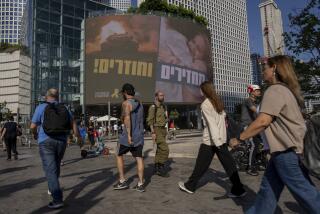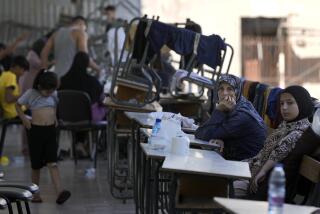Syrian schools start new year, a return to some normality for kids
DAMASCUS, Syria — The kids still ask about Mari at the Martyr Mohammed Yazin Nashar School in this capital’s western Mezzeh district.
She was a first-grader who, one afternoon last year, was standing on the balcony of her parents’ apartment after school when a car bomb exploded on the street below. The shrapnel took Mari’s life.
Her distraught mother, a longtime teacher at the school, asked for a transfer. Mari was her only child.
“The mother couldn’t bear working here anymore; it was too much for her,” said Bushra Khalil, a psychologist at the school. “The children today continue to ask about Mari. That is their No. 1 question.”
Despite a raging civil war, schools opened last month across the capital and elsewhere in government-controlled swaths of Syria, where officials have long boasted of a comprehensive and free public education system. In Damascus, more than 800 schools opened their doors to about 500,000 students, said Atef Hassan, a veteran teacher and official at the Ministry of Education.
Administrators insisted on starting fall classes on time despite the daunting challenges facing Syria’s battered educational infrastructure.
Hundreds of schools have been converted into shelters as war has forced more than a quarter of the nation’s 23 million people from their homes, according to United Nations estimates. A UNICEF study this year found that at least 1,500 schools nationwide were being used as shelters and that an additional 2,400 had been damaged or destroyed.
In some areas — especially in opposition-controlled zones, where most schools appear to be shuttered or damaged — armed factions have occupied the sites. The tens of thousands killed in the more than two years of conflict include many students and instructors. Each side has accused the other of targeting teachers.
In Damascus, multitudes of families have migrated from the war-battered suburbs to urban districts such as Mezzeh, generally considered among the capital’s safest areas despite occasional rebel car bombings and mortar strikes. The influx has boosted class sizes and forced many schools to institute split shifts, with morning and afternoon sessions.
Still, officials say they have secured space for every child, and salaries for teachers, administrators and others, despite a free-falling national economy.
“Life goes on, we can’t give up,” said Samir Suleiman, principal of Martyr Mohammed Yazin Nashar School, where the halls and classrooms were alive with the voices of children. “We will not allow anyone to take away our children’s education and wipe the smiles from their faces.”
Even with the war, officials say, standardized test scores for graduating seniors in June were as high as in any other year. This was achieved despite the fact that some students had to travel across battle lines from homes in opposition-held areas to loyalist zones where the tests were held. The exam results are used for college placement.
As the school year approached, billboards and posters urged parents to register their children, even if the youngsters lack documentation, a common problem here. The fighting and shelling have left many families without their most precious belongings, including crucial documents such as birth certificates and identity cards.
This fall’s enrollment at Suleiman’s school numbers 1,300, among them about 300 displaced children who have moved to Mezzeh, the principal said. That has increased the average class size to 37 from about 30. Other schools have seen higher influxes of displaced students.
A visit to the school in Mezzeh, a five-story brick building, revealed an old-fashioned institution where nothing appeared out of the ordinary.
Seemingly at-ease children played basketball, soccer and other games in the concrete backyard. Inside classrooms, students in blue smocks and green-and-blue scarfs — the color and stripes vary with grade levels — sat two or three together on wooden benches at traditional desks, eyes fixed on teachers positioned dutifully at blackboards. A visiting journalist, accompanied by the principal, was greeted with animated, teacher-prompted salutations of “Good morning!” in English and Arabic.
The kids seemed happy to be back with their classmates, away from the sometimes claustrophobic home atmosphere. Many parents, fearing attacks that can come at any moment, are not allowing their children out on their own. In such a charged atmosphere, school can represent a liberation of sorts.
“Everything seems just normal here,” said Zahara, a bespectacled sixth-grader considered one of the top students. “Nothing has changed.”
Still, parents and administrators noted children’s fear of violence, especially car bombings, which are sudden, indiscriminate and terrifying killers and key weapons of antigovernment insurgents. The war has created a roiling sense of insecurity and volatility in the lives of youngsters who yearn for stability.
“Just changing a child’s environment can be difficult,” said Zuhair Khatab, a strapping history teacher. “And so many students have been separated from their homes, their neighborhoods, taken away from their friends and lost family members. Of course this can be very disruptive.”
There is no outward indication at the school that a war is tearing the country apart, beyond some idealized images of Syrian troops posted on walls along corridors. Portraits of President Bashar Assad and his late father and predecessor, Hafez, seem to adorn every classroom and office, as is typical of most institutions here, public and private.
Some opposition advocates who have relocated to government-controlled areas have kept their children away from classes, viewing the public education system as an incubator of propaganda. “I refuse to send kids to a government school because I do not trust this regime,” said one opposition-backing father, who gave a common nickname, Abu Mohammed, for safety reasons.
School administrators here are aware of such sentiment, common enough in deeply divided Syria. But they call such decisions shortsighted.
“I respect a parent’s opinion to do what they want with their children, but this kind of thing only hurts the child,” said Suleiman, the principal. “The government is not going to fall because someone keeps their kids out of school. The schools are not gong to close down. This just deprives children of an education.”
Special correspondent Nada Kettunen contributed to this report.
More to Read
Sign up for Essential California
The most important California stories and recommendations in your inbox every morning.
You may occasionally receive promotional content from the Los Angeles Times.










